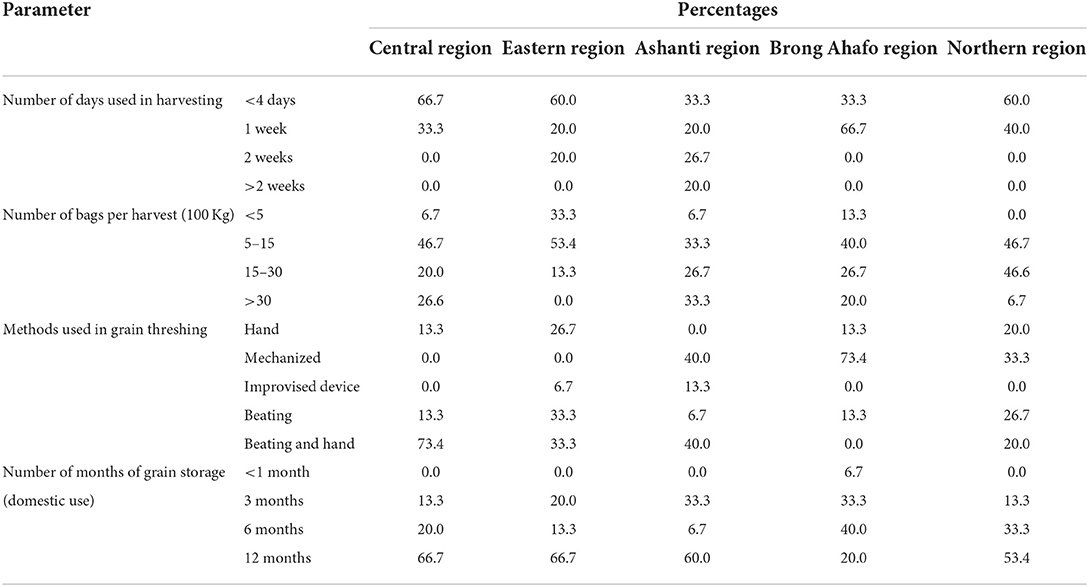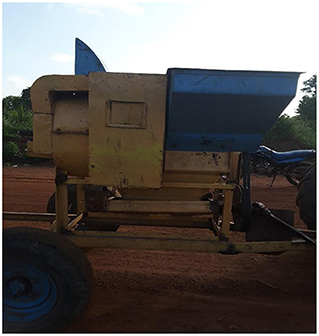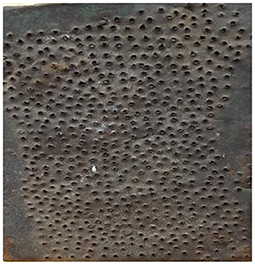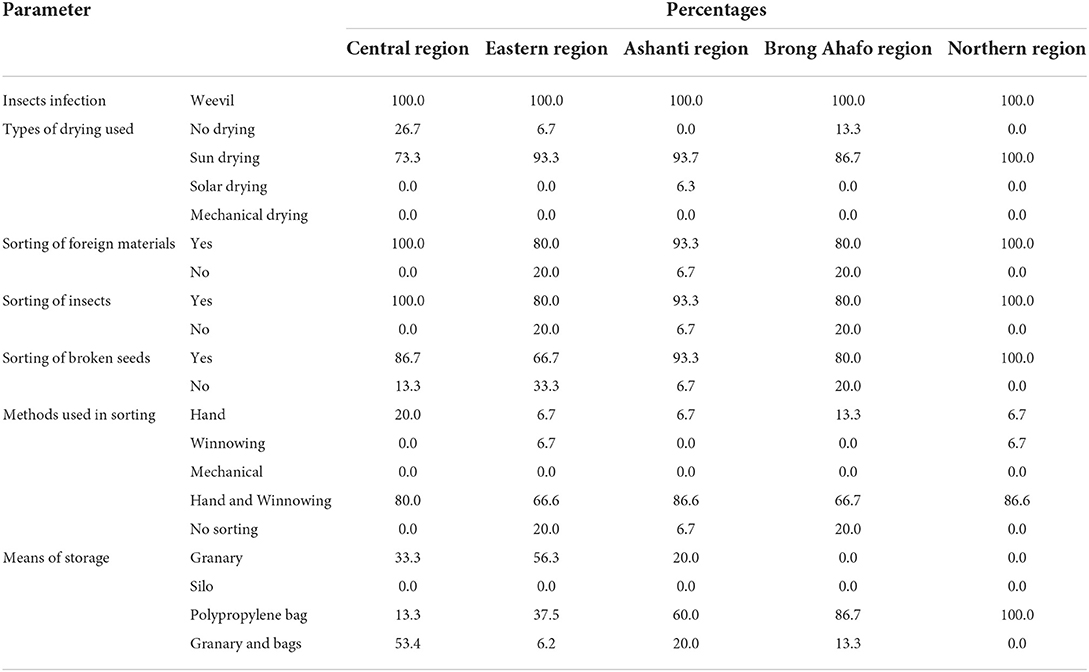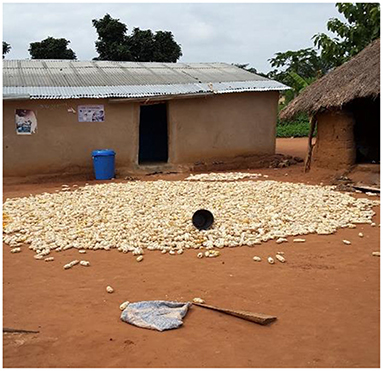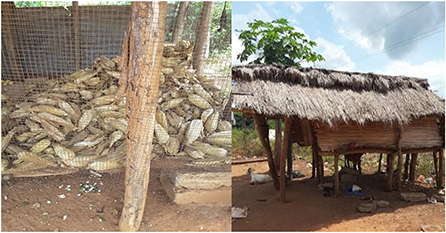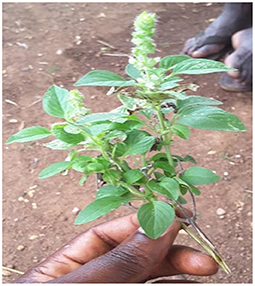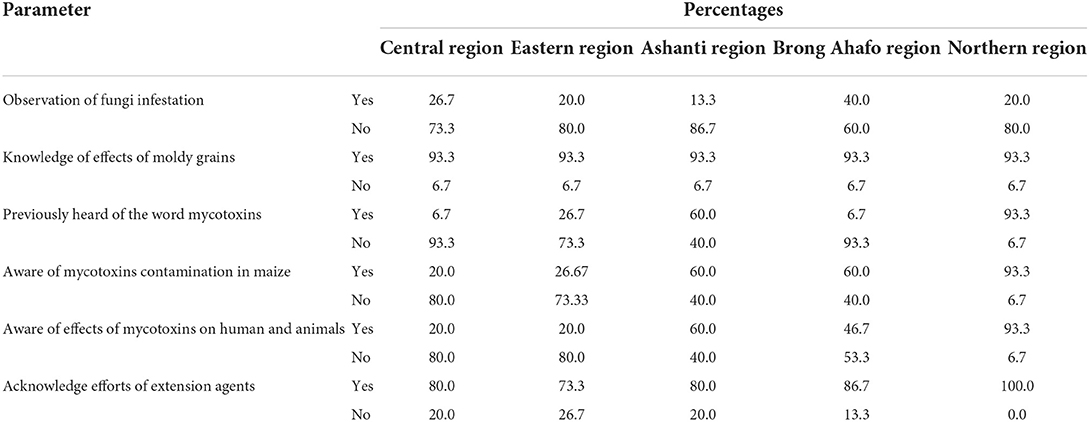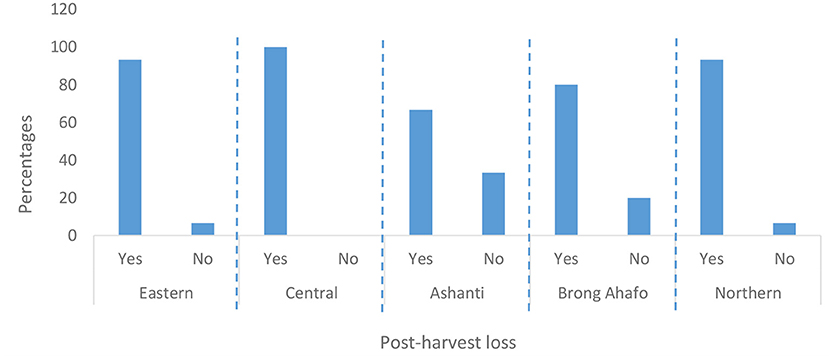- 1Radiation Technology Centre, Biotechnology and Nuclear Agriculture Research Institute, Ghana Atomic Energy Commission, Accra, Ghana
- 2Agricultural and Biosystems Engineering Department, Iowa State University of Science and Technology, Ames, IA, United States
Maize is a major staple crop mainly produced by smallholder farmers in developing nations. Grain losses happen in Sub-Saharan Africa, and therefore the objective of this study was to assess the different kinds of pre-harvest and post-harvest losses that maize farmers in Ghana encounter. The storage practices, and farmers' awareness and knowledge of mycotoxin contamination in maize were also assessed. The study area had five regions, and three districts per region. The study sites were selected purposefully because of the prior knowledge of farmers on maize production. A semi-structured questionnaire was used to collect the data, and a purposive sampling technique was used to select 75 maize farmers for the interview. The male maize farmers were many compared to females. Over 70% of farmers were at least 40 years. Over 50% of farmers had basic education except those in the northern region. Grain yields were generally low, and at least 60% of farmers experienced post-harvest loss. The period of grain storage and the storage techniques were the prerogatives of the farmers but largely dependent on farmers' financial status. Farmers basically used synthetic chemicals, and a few of the farmers decided to use plant materials during grain treatment.
Introduction
Maize is a major crop in the agricultural sector of Ghana, and also as a food security crop. Maize crop is well adapted, and grown in all the agro-ecological zones in Ghana (1, 2). However, they are dominantly grown in the middle to southern zones (3). Maize production is about 31% of the food crops under cultivation, and 70% of the total cereal production in Ghana (2). Maize is a staple crop which is highly used at the household level compared to industrial scale. Maize consumption accounts for over 25% of calories consumed of which about 75% comes from local production (2). The high demand for domestic consumption has resulted in increased maize production. Therefore, the production volume of maize had increased from 2 million metric ton to 3.1 million metric ton between 2017 and 2020 (4).
Maize grains undergo various cleaning processes before storage. To extend the shelf-life of stored grain, grain are protected from pests and other unfavorable environmental conditions (5). For decades, many traditional methods have been used to keep grains in safe storage. However, other modern and advanced post-harvest techniques contemporary exist. In 2012, post-harvest loss (PHL) in maize in Ghana was as high as about 70% (6). There are primary, secondary and tertiary factors which can result in PHL in maize (7). The primary factors may include genetic, pest and diseases, physiological, environmental, storage infrastructure, and processing. The secondary factors may include road network accessibility, transportation, market information, infrastructure, knowledge, and consumer behavior. Tertiary factors may include policy of government, investments in agriculture, advocacy groups, and participation by private sector among others. The primary, secondary and tertiary factors interact to determine the extent of PHL.
Mycotoxin contamination in maize grain has human and animal health issues, and maize quality and quantity loss issues which are major challenges in Ghana. To improve food and nutrition security, molds contamination and PHL in grains should be reduced. This is because the loss in grain quality and quantity increases food prices and reduces access and availability of nutritious food. Farmer's purchasing power reduces and poverty level then rises (8). PHL in SSA is still high although steadily decreasing, therefore the aim of this study was to assess the different kinds of pre-harvest and post-harvest losses that maize farmers in Ghana encounter. The storage practices, and farmers' awareness and knowledge of mycotoxin contamination in maize were also assessed.
Methodology
Study area and administering of interviews in Ghana
A pre-survey was tested in Akuapim South District in mid-May, 2016. See Supplemented material for actual survey questions asked of the farmers. The actual study area had five regions, and each region had three districts (Table 1). The study sites were purposely selected because those areas have larger population of maize farmers who cultivate maize in relatively larger acreage (3, 5, 9–11). The agro-ecological zones within which this study happened are found in Figure 1. The differences between the agro-ecological zones are based on the amount of rainfall, differences in soils, and general crops found in that zone. A semi-structured questionnaire was used to collect the data. A purposive sampling technique was used where 75 maize farmers were judgmentally selected and interviewed between May and August 2016 through the efforts of their Agricultural Extension Agents (AEAs). Questions were asked on the major causes of pre-harvest and post-harvest losses in maize, methods and length of maize storage, grain handling practices, knowledge of mycotoxin contamination, etc. Questions were asked in participants' local language.
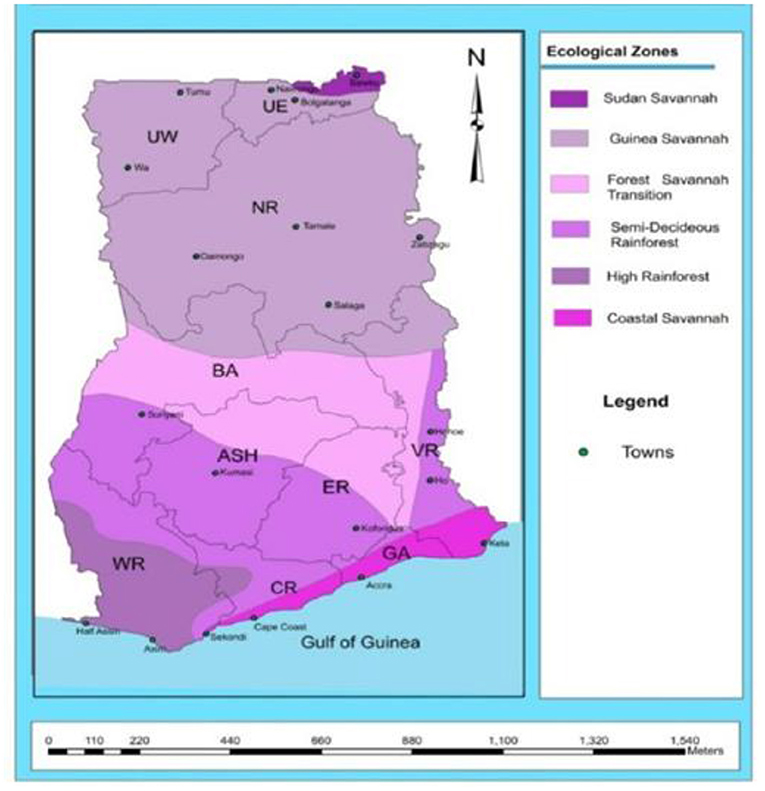
Figure 1. Ecological zones of Ghana [source: Issaka et al. (12)].
Data presentation
The data were coded and calculated in percentages. The data were presented in both tabular and graphical form. The data trends were described using descriptive statistics.
Results and discussion
Demographic information on farmers
Based on this study, the male farmers in all the five regions were more than their female counterparts (Table 2). This result contradicts the perception that female farmers in Ghana outnumber their male counterparts. Jolly et al. (13) similarly indicated that male farmers in Ghana outnumber females. Contrary, research in Tanzania and Nigeria have reported a high percentage of female farmers compared with male farmers (14–16). Women in agriculture (%) found in SSA and other developing countries ranges between 43 and 50% (17). Based on the regions surveyed, more than 60% of farmers were at least 40 years old. The youth have shown lack of interest in farming, and therefore, most farmers are above 40 years. If this trend continues across all the regions, it can affect the agricultural workforce in Ghana in the near future. This can lead to limited food supply and massive food insecurity and poverty.
At least 50% of farmers have had primary education, except farmers in NR. The number of farmers without formal education was highest in BA (47%) and NR (87%). The low level of education in the NR can be attributed to lack of schools within the farming communities some years ago. Because of illiteracy especially in NR, farmers depended mostly on their AEAs and colleagues for information. The farmers with higher levels of education were regular formal sector workers who farm as secondary job. Similarly, Suleiman et al. (16) reported that in Tanzania most maize farmers completed at least primary education.
Cultivated farm size, and grain handling before, during, and after harvest
Unlike the wives of these male farmers who cultivated an acre of land, most single-mothers cultivated 2–3 acres. This was to help them meet their financial obligations through the sale of some of the farm produce. About 73% of farmers cultivated 2–5 acres of land in BA, CR, and ER while it was 67 and 53%, respectively, in AR and NR (Table 3). A fewer percentage of farmers (20%) cultivated between 6 and 10 acres of land in BA and NR. The farmers who participated in the study were typically smallholder farmers since their farm sizes were in smaller acreages. According to FAO (17), smallholder farmers cultivate at most 25 acres (10 ha) of land.

Table 3. Farm sizes cultivated by maize farmers, and the different methods of harvesting maize grain.
Farmers experiencing pre-harvest loss was at least 93% (Table 4) while pre-harvest loss in maize grain was <1%, but it was 2% in NR. There were variations in the causative agents and extent of damage associated with pre-harvest loss amongst the regions. Generally, birds, weather, insects, plant lodging, and rodents were the causative agents. Plant lodging was rampant since it was caused by the blowing wind (uncontrollable), rodents and termites. The low level of pre-harvest loss possess less concern regarding food insecurity.
All farmers typically harvested maize using handheld machete (Table 3) due to lack of combine harvesters. The manual harvesting leads to longer days used in harvesting, thus up to 2 weeks (Table 5). The longer days used in harvesting might result in higher field loss in grain quality and quantity caused by molds and weevils. Farmers that cultivated larger acres of land had to hire casual laborers during the harvesting period. Grain yields were generally low across all the regions. Thus, CR (20%) and BA (27%) of farmers had between 500 and 3,000 kg of grain. ER (86%) had 1,500 kg, AR (60%) recorded 500–3,000 kg, and AR (33%) above 3,000 kg. NR (93%) recorded between 500 and 3,000 kg. Such low yield are attributable to non-mechanized farm operations, rain-fed farming, and inability to purchase farm supplies and inputs (fertilizers, herbicides, pesticides, insecticides, machetes, etc.). Farmers complained about unavailable financial loans and limited government subsidies on agriculture inputs and supplies. Mechanizing farming and government increasing subsidies on agriculture inputs can help increase maize grain production in Ghana. Similarly, Abass et al. (18) observed a lower yield among maize farmers in Tanzania, and they attributed it to manual farming operations. In order to avoid the hustle associated with post-harvest handling of grain, most farmers in ER sold the maize before physiological maturity (green stage) instead of allowing the grain to dry. This practice, however, is a recipe for food insecurity since scarcity and price of grain can increase.
Farmers threshed grain using their hand, beating or the combination of hand and beating methods. As in Table 5, farmers had preferred apparatus for grain threshing. Mechanical threshing was available although limited in BA, AR and NR, where 73, 40, and 33% of farmers, respectively used. The challenge associated with the use of the locally manufactured thresher (Figure 2) was the lower efficiency in threshing which results in grain loss and damage. Some farmers used improvised tools (Figure 3) during shelling. The use of threshers with higher efficiency rather than improvised tools can greatly reduce grain loss and damage. In support of this study, Abass et al. (18) reported that farmers in Tanzania shell maize grain manually.
Post-harvest grain drying, sorting, and storage
The months for storing grain was the prerogative of the farmers which varied from weeks to 12 months (Table 5). Farmers sold the grain as and when they are in need of income. Not <93% of farmers in all the regions used sun drying (Table 6). Farmers use sun drying because the energy from the sun is predominant in Ghana, and a cost-free source of energy. Interestingly, farmers sun-dry the grain lot mostly on a bare floors or cemented pads or mats or tarpaulins or large polyethylene which exposes the grain to birds, foreign contaminants, livestock, and unexpected rainfall (Figure 4). All the above can reduce grain quantity and quality, and hence, increase food insecurity and poverty among farmers. Moreover, in the AR, 7% of farmers used solar drying (Table 6). The solar dryer was manufacture from solar tent which has the ability to trap solar radiation to help dry the grain. The solar drying tent essentially maintains grain quality and quantity.
Over 67% of farmers practiced grain sorting where foreign materials, mold instead or insect infested kernel, broken kernels, broken cob, etc. were removed. Those farmers practically used handpicking or winnowing method. The inefficient way of grain sorting resulted in farmers recording higher rates of grain deterioration. Grain sorting reduces grain spoilage (19), and also maintains grain quantity, quality, and grade.
Some farmers still use traditional granary and/or and polypropylene bags (Figures 5A,B). At least 60% of farmers in AR, BA, and NR used polypropylene bags to store grain. The traditional granary which is susceptible to insects and rodents attack was extensively used in ER and CR. A few farmers used hermetic storage techniques which keep grain quite safe in storage. But farmers were not using the hermetic techniques, and therefore PHL in grain was high. Most farmers (87%) tend to sell their entire grain just after harvest, and keep a little for domestic consumption. Farmers in CR, ER, AR, and BA stored grain for a maximum of 6 months because of the two-seasonal cultivation periods experienced each year.
Post-harvest grain treatment
About 87% of farmers in CR used synthetic insecticides in grain treatment (Table 7). In ER and AR, about 50% of farmers either used or did not use synthetic insecticides. While in BA 20% of farmers used synthetic insecticides, and 40% in NR used fumigants. Some farmers preferred using plant materials to treat grain (NR, 87%; ER, 27%; and AR, 7%). A few farmers used synthetic insecticides in BA because most farmers sold out grain days or weeks just after harvest. Hence chemical treatment was unnecessary. Most farmers in NR used plant materials to treat grain, hence low synthetic insecticides (fumigants) application. Some farmers in NR used a combination of fumigants and plant materials during grain storage. The common insecticides used by farmers were actellic super, phosphine (fumigant), etc. The predominant use of synthetic insecticides can partly be linked to their market availability and relatively lower price compared with other botanicals. The common plant materials used by farmers that participated in the interview included neem, red hot pepper and basil plants (Figure 6). The farmers claimed that the plant materials used were effective against maize weevils, although they did not extract the essential oils. Many studies have reported the potency of insecticidal essential oils extracted from different plant materials against insects (20–23).
Mold infestation, knowledge of farmers, and AEAs' activities
In Table 8, the percentage of farmers that experienced post-harvest mold attacks ranged from 13 to 40%, and BA recorded the highest. The higher molds infestation in BA can be associated with higher rainfall pattern in BA. This is because molds thrive on wet or damp grain (24), especially when the process of harvesting and/or drying is delayed. As indicated by Gbangou et al. (25), southern and transition zones have the highest average seasonal rainfall. At least 90% of all the participated farmers had knowledge of the effects of using moldy grain. Farmers knowledge of the effects of mycotoxin on humans and animals health were 93, 60, 60, 27, and 20%, respectively, in NR, AR, BA, ER, and CR. Despite the low formal education level of farmers in NR, their knowledge of mycotoxin was extensive. This was basically because of the regular education provided by the AEAs. Surprisingly, most educated farmers lacked knowledge of mycotoxin and its effects. In Malaysia, Leong et al. (26) similarly found no significant association linking knowledge of aflatoxin to education level of farmers. Notwithstanding, contrary findings were reported by Jolly et al. (27) and Suleiman et al. (16). The efforts of the AEAs were greatly acknowledged by not <73% of farmers across all regions. An example of such efforts was observed in NR regarding farmers' knowledge of mycotoxin.
PHL and pest infestations
More than 67% of farmers in all five regions experienced PHL (Figure 7). This means farmers in all the five regions experience some form of PHL. PHL was predominantly caused by pest infestation (36–94% of farmers, Figure 8). Pest infestation was due mostly to insects, followed by rodents and then molds (Figure 9). Sitophilus zeamais was the only insect that infested the grain (Table 2). The observance of S. zeamais in stored grain is worrying because of its economic importance (grain loss). Such grain loss experienced by farmers may result in food insecurity and loss of income. The S. zeamais infestation may have been caused by delayed harvest practiced by farmers and poor storage facilities. Early harvest of grain reduces weevil infestation which begins from the field. PHL have similarly been reported in many studies (16, 18, 28–31). Molds infestation was not reported as severe compared to rodents. Also, the use of poor storage facilities worsened PHL.
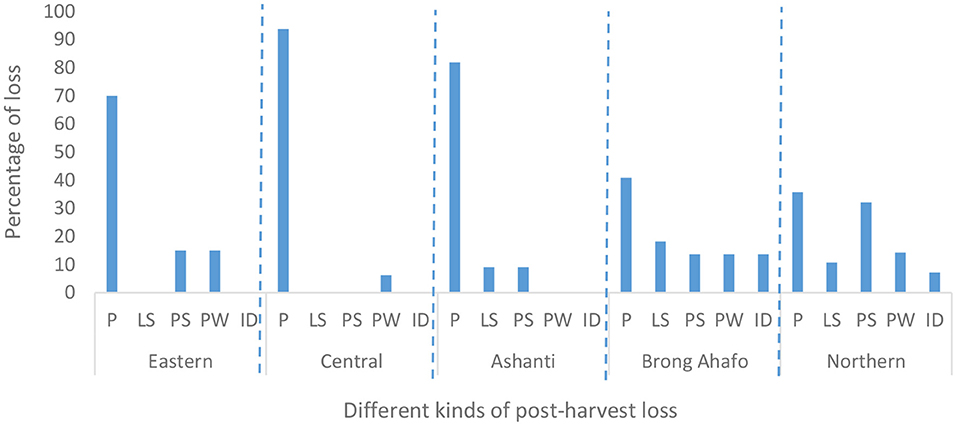
Figure 8. Different kinds of post-harvest loss (PHL) observed by maize farmers. P, pest infestation; LS, lack of storage facility; PS, poor storage facility; PW, poor weather; ID, improper drying.
Conclusion
The number of male maize farmers surpassed their female counterparts. Males cultivated larger acreage of land compared with female farmers. The participated farmers were basically smallholder farmers since they cultivate <25 acres of land. Almost all the farmers used conventional practices in their activities except those who have access to locally manufactured machines. PHL was generally caused by maize weevils or rodents but not molds. Farmers used synthetic insecticides and plant material to control maize weevils. Generally, the knowledge of farmers on molds and mycotoxin effects was good, but was exceptional in NR. The efforts of the AEAs were greatly acknowledged in all the regions.
Data availability statement
The raw data supporting the conclusions of this article will be made available by the authors, without undue reservation.
Ethics statement
Ethical approval for this study and written informed consent from the participants of the study were not required in accordance with local legislation and national guidelines.
Author contributions
KR and BD designed the study. BD implemented the survey, collected and analyzed data, and drafted the manuscript. KR supervised the study and revised the manuscript. All authors contributed to the article and approved the submitted version.
Funding
This work was funded by the Feed the Future Ghana Agriculture Technology Transfer Project under the International Fertilizer Development Center (USAI-Ghana) in partnership with ISU.
Acknowledgments
The authors greatly acknowledge the immense time and efforts of the AEAs and participants who helped in various ways during the data collection.
Conflict of interest
The authors declare that the research was conducted in the absence of any commercial or financial relationships that could be construed as a potential conflict of interest.
Publisher's note
All claims expressed in this article are solely those of the authors and do not necessarily represent those of their affiliated organizations, or those of the publisher, the editors and the reviewers. Any product that may be evaluated in this article, or claim that may be made by its manufacturer, is not guaranteed or endorsed by the publisher.
Supplementary material
The Supplementary Material for this article can be found online at: https://www.frontiersin.org/articles/10.3389/fnut.2022.725815/full#supplementary-material
References
1. Adu GB, Abdulai MS, Alidu H, Nutsugah SK, Buah SS, Kombiok JM, et al. Recommended Production Practices for Maize in Ghana. CSIR-AGRA Maize Production Guide (2014). Accra: CSIR-AGRA. p. 1–18.
2. Mordor Intelligence. Ghana Grain Market—Growth, Trends, COVID-19 Impact, Forecast (2022–2027). (2022). Available online at: https://www.mordorintelligence.com/industry-reports/grain-market-in-ghana#:~:text=Maize%20Dominates%20the%20Grain%20Market%20in%20Ghanaandtext=Maize%20is%20the%20major%20grain,cultivated%20staple%20crop%20in%20Ghana (accessed May 10, 2022).
3. Rondon M, Ashitey E. Grain and Feed Annual Report: Assessments of Commodity and Trade Issues in Ghana. GAIN Report. Washington, DC: USDA Foreign Agricultural Service (2011)
4. Sasu DD. Statista: Production of Maize in Ghana 2010–2020. (2022). Available online at: https://www.statista.com/statistics/1300694/production-volume-of-maize-in-ghana/ (accessed March 1, 2022).
5. Darfour B, Rosentrater KA. Maize in Ghana: an overview of cultivation to processing. In: Agricultural and Biosystems Engineering Conference Proceedings and Presentations, Orlando, FL. (2016). p. 480.
6. FAO Statistical Division. (2012). Available online at: http://faostat.fao.org (accessed December 10, 2016).
7. Sugri I, Abubakari M, Owusu RK, Bidzakin JK. Postharvest losses and mitigating technologies: evidence from Upper East Region of Ghana. Sustain Fut. (2021) 3:100048. doi: 10.1016/j.sftr.2021.100048
8. Opit G. Oklahoma State University receives USAID grant to help with post-harvest loss reduction in Ghana. In: A press statement by the project leader and assistant professor in OSU Department of Entomology and Plant Pathology. (2014).
9. Edwards JK. Storage of maize in Ghana: past, present and future role of the Ghana Food distribution Corporation. In: Odamtten GT, Clerk GC, editor. Mitigation of Stackburn in Woven Polypropylene Bag-Stack Maize Grains for Improved Food Security in Sub-Saharan Africa. European Union Project on Stackburn of Maize in Commercial Storage (STD3 Project ERBT3* CT920097). (1995). Accra: National Science and Technology Press. p. 11–15.
10. Morris ML, Tripp R, Dankyi AA. Adoption and Impacts of Improved Maize Production Technology: A Case Study of the Ghana Grains Development Project. Economics Program Paper 99-01. Mexico, DF: CIMMYT (1999).
11. Darfour B, Rosentrater KA. Grain cultivation and its association problems: overview of Ghana. In: Agricultural and Biosystems Engineering Conference Proceedings and Presentations, Orlando, FL (2016). p. 479.
12. Issaka RN, Buri MM, Tobita S, Nakamura S. Indigenous fertilizing materials to enhance soil productivity in Ghana. Soil fertility improvement and integrated nutrient management—a global perspective. InTech. (2012) 7:119–34. doi: 10.5772/27601
13. Jolly CM, Bayard B, Awuah RT, Fialor SC, Williams JT. Examining the structure of awareness and perceptions of groundnut aflatoxin among Ghanaian health and agricultural professionals and its influence on their actions. J Socio Econ. (2009) 38:280–7. doi: 10.1016/j.socec.2008.05.013
14. Ellis A, Blackden M, Cutura J, MacCulloch F, Seebens H. Gender and Economic Growth in Tanzania: Creating Opportunities for women. Washington DC: World Bank Publications (2007).
15. Ogunlela YI, Mukhtar AA. Gender issues in agriculture and rural development in Nigeria: the role of women. Human Social Sci J. (2009) 4:19–30.
16. Suleiman R, Rosentrater KA, Bern C. Postharvest Practices and Mycotoxins of Maize in Three Agro-Ecological Zones in Tanzania. Ph.D. Dissertation. Ames, IA: Iowa State University of Science and Technology, Department of Agricultural and Biosystems Engineering (2016). doi: 10.13031/aim.201700634
17. FAO. Sustainability Pathway: Smallholders and Family Farmers. (2012). Available online at: http://www.fao.org/fileadmin/templates/nr/sustainability_pathways/docs/Factsheet_SMALLHOLDERS.pdf (accessed December 10, 2016).
18. Abass AB, Ndunguru G, Mamiro P, Alenkhe B, Mlingi N, Bekunda M, et al. Postharvest food losses in a maize-based farming system of semi-arid savannah area of Tanzania. J Stored Prod Res. (2014) 57:49–57. doi: 10.1016/j.jspr.2013.12.004
19. Hell K, Fandohan P, Bandyopadhyay R, Kiewnick S, Sikora R, Cotty PK, et al (2008). Pre- and Postharvest Management of Aflatoxin in Maize: An African Perspective. BMZ and GTZ for supporting this research through Project No. 7860.6.01.00. Available online at: http://ag.arizona.edu/research/cottylab/apdfs/hell%20et%20al%202008.pdf (accessed December 17, 2016).
20. Christian EJ, Goggi AS. Aromatic plant oils as a fungicide for organic corn production. Crop Sci. (2008) 48:1941–51. doi: 10.2135/cropsci2007.06.0341
21. Benzi V, Stefanazzi N, Ferrero AA. Biological activity of essential oils from leaves and fruits of pepper tree (Schinus molle L.) to control rice weevil (Sitophilus oryzae L.). Chilean J Agric Res. (2009) 69:154–9. doi: 10.4067/S0718-58392009000200004
22. Ebadollahi A, Safaralizadeh MH, Pourmirza AA. Fumigant toxicity of Lavandula stoechas L. oil against three insect pests attacking stored products. J Plant Protect Res. (2010) 50:56–60. doi: 10.2478/v10045-010-0010-8
23. Ayvaz A, Sagdic O, Karaborklu S, Ozturk I. Insecticidal activity of the essential oils from different plants against three stored-product insects. J Insect Sci. (2010) 10:1–13. doi: 10.1673/031.010.2101
24. GrainPro. 4. Tips to Avoid Mold Growth in Stored Grains. (2015). Available online at: https://news.grainpro.com/4-tips-on-how-to-avoid-mold-growth-in-stored-grains (accessed December 17, 2016).
25. Gbangou T, Ludwig F, van Slobbe E, Greuell W, Kranjac-Berisavljevic G. Rainfall and dry spell occurrence in Ghana: trends and seasonal predictions with a dynamical and a statistical model. Theor Appl Climatol. (2020) 141:371–87. doi: 10.1007/s00704-020-03212-5
26. Leong YH, Rosma A, Latiff AA, Izzah AN. Associations of serum aflatoxin B 1-lysine adduct level with socio-demographic factors and aflatoxins intake from nuts and related nut products in Malaysia. Int J Hyg Environ Health. (2012) 215:368–72. doi: 10.1016/j.ijheh.2011.12.005
27. Jolly P, Jiang Y, Ellis W, Awuah R, Nnedu O, Phillips T, et al. Determinants of aflatoxin levels in Ghanaians: socio-demographic factors, knowledge of aflatoxin and food handling and consumption practices. Int J Hyg Environ Health. (2006) 209:345–58. doi: 10.1016/j.ijheh.2006.02.002
28. Demissie G, Teshom A, Abakemal D, Tadesse A. Cooking oils and “Triplex” in the control of Sitophilus zeamais Motschulsky (Coleoptera: Curculionidae) in farm-stored maize. J Stored Prod Res. (2008) 44:173–8. doi: 10.1016/j.jspr.2007.10.002
30. Kaminski J, Christiansen L. Post-harvest loss in sub-Saharan Africa-what does farmers say? Global Food Security. (2014) 3:149–58. doi: 10.1016/j.gfs.2014.10.002
Keywords: pre-harvest losses, post-harvest losses, maize grain storage, Ghana, storage
Citation: Darfour B and Rosentrater KA (2022) Pre-harvest and post-harvest farmer experiences and practices in five maize growing regions in Ghana. Front. Nutr. 9:725815. doi: 10.3389/fnut.2022.725815
Received: 20 November 2021; Accepted: 29 July 2022;
Published: 19 August 2022.
Edited by:
Angel Gil-Izquierdo, Center for Edaphology and Applied Biology of Segura (CSIC), SpainReviewed by:
Isaac Gershon Kodwo Ansah, University for Development Studies, GhanaJoseph Oppong Akowuah, Kwame Nkrumah University of Science and Technology, Ghana
Copyright © 2022 Darfour and Rosentrater. This is an open-access article distributed under the terms of the Creative Commons Attribution License (CC BY). The use, distribution or reproduction in other forums is permitted, provided the original author(s) and the copyright owner(s) are credited and that the original publication in this journal is cited, in accordance with accepted academic practice. No use, distribution or reproduction is permitted which does not comply with these terms.
*Correspondence: Kurt A. Rosentrater, a2Fyb3NlbnRAaWFzdGF0ZS5lZHU=
 Bernard Darfour
Bernard Darfour Kurt A. Rosentrater
Kurt A. Rosentrater


